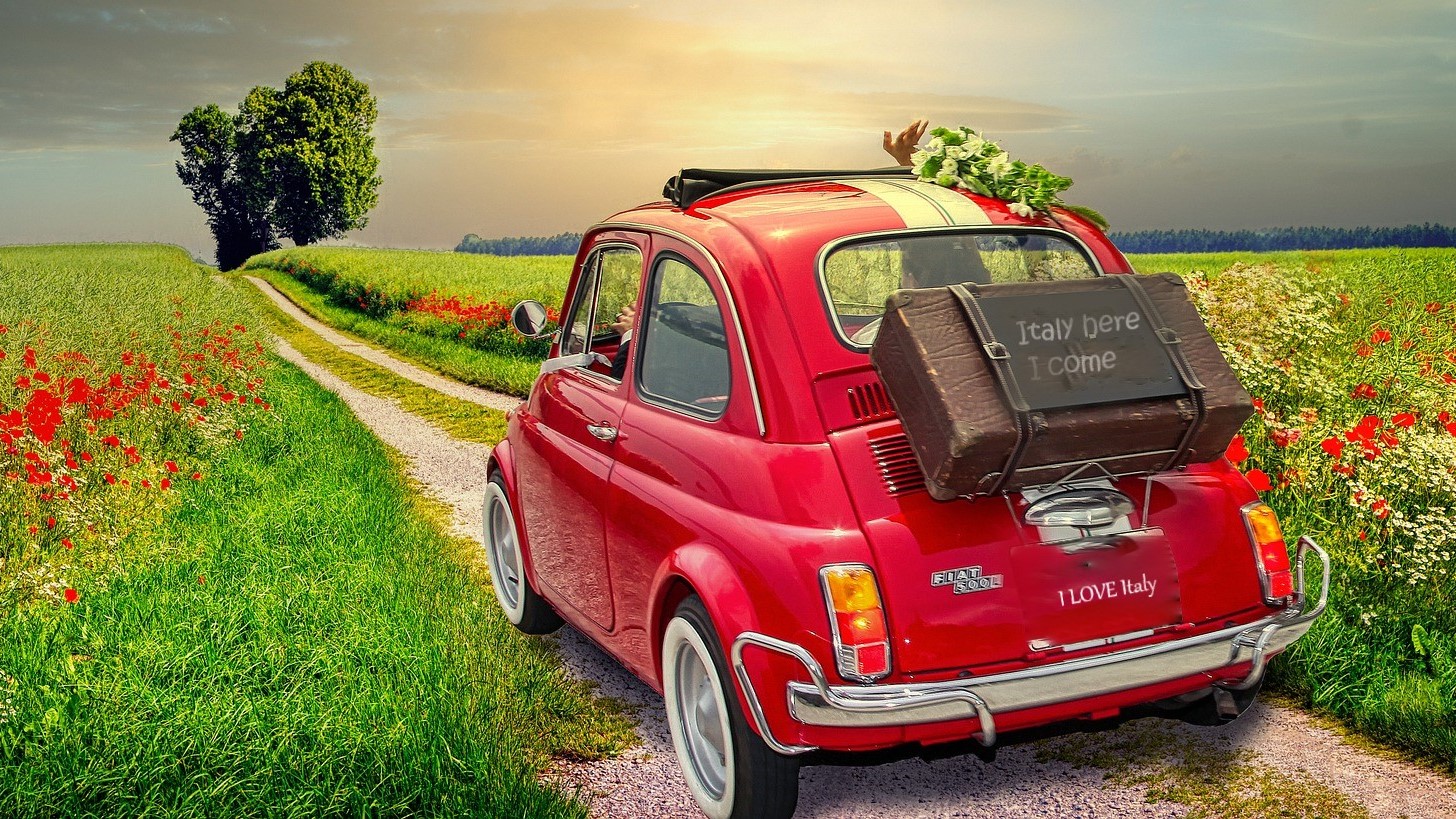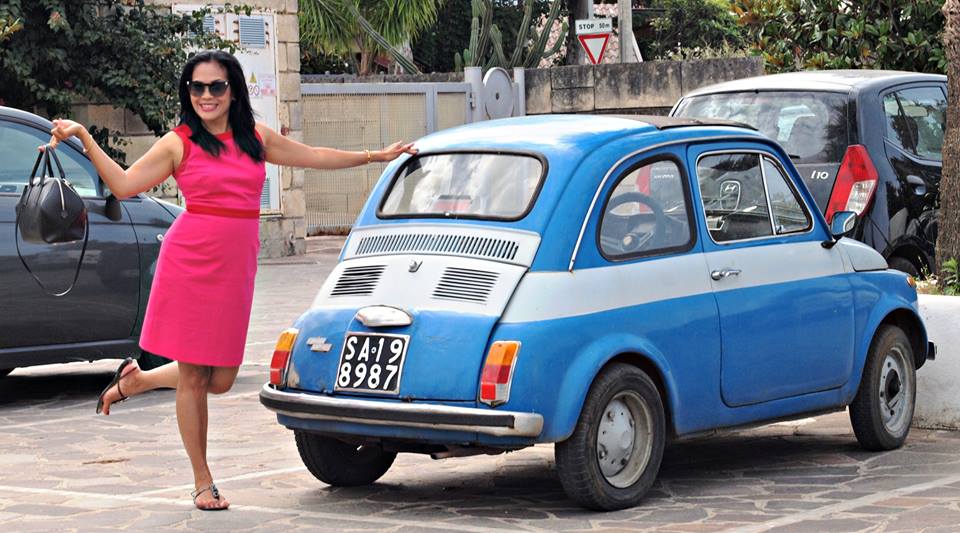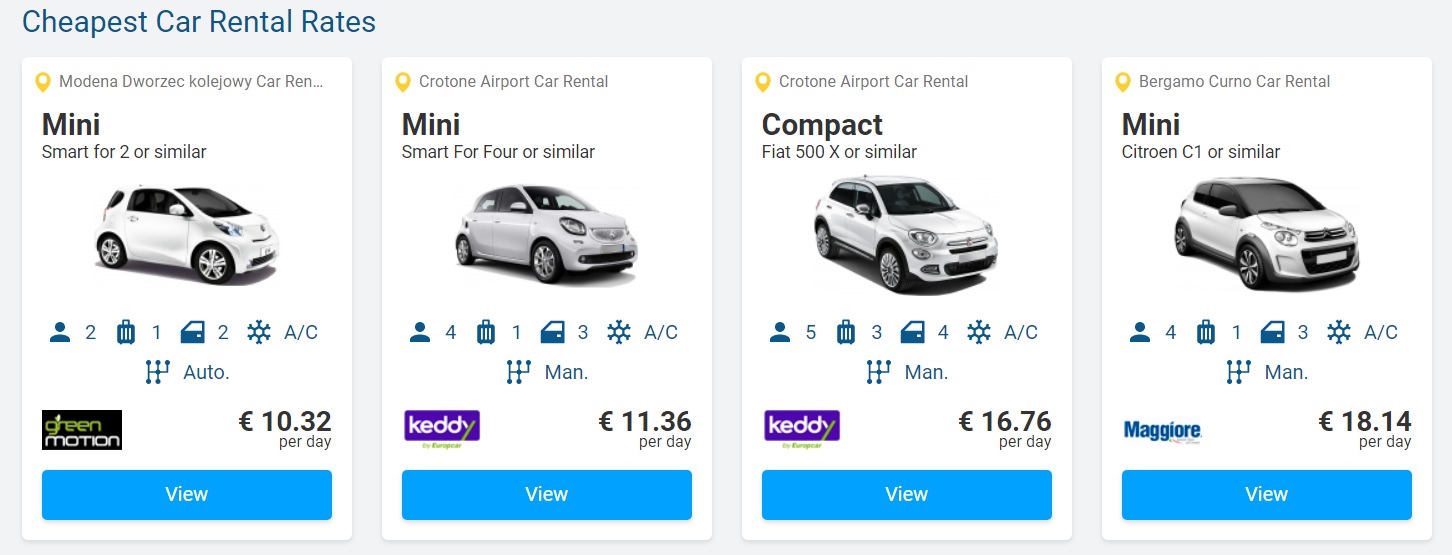Italy Car Rental Guide + Top 10 Road Trips
For Italy's 10 Greatest Road Trips: Scroll to the bottom of the article.
Is Renting a Car in Italy Worth It??
Car rental in Italy is undoubtedly the best way to explore the secret places, quaint country villages, and out-of-the-way towns of the Italian countryside. Unless, of course, you are great on a bike!
Trains in Italy (read our guide to the top 10 train journeys) are excellent and affordable, but they're really only ideal if you are visiting the towns and cities.
To really discover Italy and have a holiday of a lifetime, you need to base yourself in a country town, in the heart of the Italian countryside, and rent a car.
If you are going to be visiting only cities like Rome, Florence, Naples, or Milan, then you are better off without a car rental anyway. The traffic in the major Italian cities is scary, with Rome and Naples being by far the worst cities to drive in. Venice, of course, has no cars, motorbikes, or bicycles, so no car is ever needed to explore Venice.
Know Before you Go: Avoid the Dreaded ZTL Zones
Should you be the fearless type and decide to drive in cities like Rome, Milan, etc., you'll need to know where the restricted driving zones (known locally as ZTL zones) are, or you'll risk HUGE fines—here are the essential maps and vital information on all the main ones.
So, what is a ZTL?
ZTL stands for Zona a Traffico Limitato, and they are restricted traffic zones found in many Italian cities, designed to reduce congestion and protect historic areas. If you’re driving in Italy, it’s crucial to know how to avoid entering these zones, as fines for violations can be hefty.
Here’s how to avoid the dreaded fines:
- Research Ahead: Before visiting any Italian city, check for ZTL zones, especially in popular tourist areas like Florence, Rome, and Milan.
- Look for Signs: ZTL areas are clearly marked with signs showing red circles and hours of restriction. Pay close attention to these, as some zones are restricted at certain times of the day.
- Parking Outside the ZTL: Use parking lots outside the city center or in areas not affected by ZTL rules. Then, explore the city on foot or by public transport.
- Hotel Guest Exceptions: Some hotels can arrange temporary ZTL access for their guests, so confirm with your accommodation in advance.
Avoiding these zones will save you from unnecessary fines and stress!
Who to Rent With?
When it comes to car rental in Italy, I have tried a variety of car rental companies. Some are good, and some are very bad.
Most of the big names, like Avis and Budget, have always provided me with good service. While not always the cheapest, they are reliable, and you're unlikely to encounter any nasty surprises. However, it is best to compare the ratings and prices of the different companies before deciding, and the best way to do that is on Discover Car Hire.
Is Renting a Car in Italy Expensive?
Unfortunately, the answer is yes. I tried to save money once by renting a car from a very cheap and very tiny car rental company, and... long story really... less said the better. The moral of the story is: don't make the same mistake.
My advice is to rent your car before you arrive, as rates are normally better this way and you have a greater choice of cars.
FAQ: What Are the Requirements to Rent a Car in Italy?
How old do you need to be to rent a car in Italy?
The minimum age to rent a car in Italy is typically 18 years old. However, most car rental companies may charge an additional fee for drivers under the age of 25.
Can I use my license to drive in Italy?
EU licenses can be used in Italy. If your license was not issued by an EU country, then you will usually need an International Driving Permit (IDP).
There are a few exceptions, but the USA, Canada, Australia, and New Zealand license holders all require an IDP. One exception is the UK, at least according to the UK Government (https://www.gov.uk/driving-abroad/international-driving-permit).
Some car rental companies will never ask for your International Driving Permit; however, if the police stop you, they will want proof of insurance, registration papers, your domestic driver's license, and an International Driving Permit (IDP). Failure to have any of these could result in a hefty fine.
Can I rent a car in Italy without a credit card?
Most car rental companies require a credit card for the rental transaction. Debit cards may not be accepted in some cases. It's essential to check with the specific car rental agency for their policies regarding payment methods.
Which Type of Car Should You Rent in Italy?
Of course it depends on many factors: your budget, your luggage, and the size of your travel group. Some people will rent a special dream car for a few days; that could be a Ferrari rental or a classic old Fiat 500; others hire campervans.
Generally, smaller cars are easier to manage in Italy, as driving down some of the narrow lanes in a huge SUV can be rather challenging. I guess that is why the Fiat 500 (the modern version) is still one of the most popular rental options.
Are tolls common on Italian roads, and how do I pay them?
Yes, tolls are common on highways. Toll booths accept cash, credit cards, or electronic toll collection devices. Rental cars often come equipped with a device for automatic toll payment.
What are the speed limits in Italy, and are they strictly enforced?
Speed limits vary, but common limits are 50 km/h in urban areas, 90-110 km/h on rural roads, and 130 km/h on highways. Speeding is strictly enforced, and fines can be substantial. The fines often arrive many months after you've returned home and can come as a very nasty shock. Be careful out there.
Is there Uber in Italy
If you're thinking, "Why rent a car in Italy when I can Uber?" Think again. Uber, as you know it, doesn't exist in Italy. You are better off with a car rental or public transport.
Thanks to bureaucracy and opposition by taxi drivers, Uber offers little more than a glorified and expensive taxi service in the major cities of Italy, like Rome, Milan, and Turin. To be honest, a taxi is more affordable, and Italian taxis are generally very expensive, which goes to show just how expensive Uber Italy is.
So, grab a taxi if you have to, rather than Uber, but make sure the meter is running before you leave; if it isn't, get out and find another. One of the top taxi scams in Italy is to say, "The meter is broken," and then to negotiate a high flat rate.
Also, have the address written on a piece of paper and give it to the driver; otherwise, you may be taken to the wrong address and then charged a fortune to redirect to the correct address. The taxi driver will tell you he didn't understand you; you gave him the wrong address, etc. So make sure there can be no misunderstandings.
Lastly, make sure you have plenty of change and small bills on you to pay the fare; otherwise, you might find the driver tells you he has no change.
The 10 Greatest Italian Road Trips
Italy is a country that boasts beautiful landscapes and charming towns, making it an ideal destination for road trips. From the snow-capped mountains of the Dolomites to the sun-kissed beaches of Sicily, Italy has some of the most beautiful drives in the world. Here are seven road trips that will leave you breathless.
Amalfi Coast:
The road that winds along the Amalfi Coast, SS163, is one of the most scenic in Italy, although if you've never driven in Italy before, it can be a little hair-raising. It is best to go early, and ideally out of season, to avoid traffic chaos.
The route hugs the coastline, with the shimmering Tyrrhenian Sea on one side and the rugged cliffs of the Lattari Mountains on the other. Explore charming towns like Positano, Amalfi, and Ravello, where you can enjoy a coffee or a gelato and soak in the stunning views, and don't miss the village of Atrani, which features in the Ripley series on Netflix.
Right at the end of the drive, you'll find Salerno. It is a fascinating city with an old town of narrow lanes and tons of character. The food is out of this world.
Dolomites:
The Dolomite Mountain range in northeastern Italy offers some of the most scenic drives in the world. The route passes through charming Alpine villages, crystal-clear lakes, and breathtaking vistas of snow-capped peaks. Take the Great Dolomite Road (SS48) and the Great Dolomite Way (SS242) to see the best views.
Tuscan Hills:
The winding roads that pass through the rolling hills of Tuscany offer a magical landscape that has inspired artists and writers for centuries. The Chiantigiana Road (SR222) is a classic drive that takes you through charming towns like San Gimignano, Montalcino, and Montepulciano. Stop by wineries and restaurants to sample the best wines and food that Tuscany has to offer.
Strada della Forra:
This scenic route winds through the deep gorges and rocky cliffs of Lake Garda, the largest lake in Italy. The road, carved out of the mountainside, passes through tunnels, over bridges, and past stunning waterfalls. Take the Gardesana Occidentale (SS45bis) from Riva del Garda to Limone sul Garda for a thrilling drive. More on this road trip here.
San Boldo Pass:
Embark on a thrilling and picturesque journey along the San Boldo Pass in the Veneto region of Italy. This mountain pass, officially known as Passo San Boldo, is a marvel of engineering and offers a unique and unforgettable driving experience. The pass connects the towns of Trichiana and Tovena and is renowned for its series of hairpin bends and tunnels carved into the rocky mountainside.
As you navigate the winding road, you'll be treated to breathtaking views of the surrounding Dolomite peaks and lush green valleys. The road passes through a total of six tunnels, each with its own distinct charm and character. The tunnels, with their narrow openings and stone walls, create a sense of adventure and add to the allure of the journey.
The San Boldo Pass is best explored during the warmer months, from late spring to early autumn, when the weather is pleasant and the pass is open to traffic. It's important to note that due to its narrow and winding nature, the road may not be suitable for large vehicles or those who are uncomfortable with steep inclines and tight turns. Don't miss the wonderful little town of Cison di Valmarino (click for my guide to all its many secrets). Also, visit some of the world renowned wineries in the area.
Stelvio Pass:
The Stelvio Pass is one of the most famous and scenic roads in the Italian Alps. Located in the mountains of South Tyrol, this mountain pass offers breathtaking views, spectacular hairpin bends, and stunning panoramas. The road leading to the Stelvio Pass is the SS38, which offers a mix of sweeping curves, steep ascents, and jaw-dropping panoramic views.
The Stelvio Pass is a paradise for driving enthusiasts and cyclists alike, attracting thrill-seekers from around the world. Be prepared for varying weather conditions, as the pass is open only during the summer months due to heavy snowfall in winter. Take your time to appreciate the grandeur of the surrounding landscape, and don't forget to stop at the summit to capture unforgettable photos and enjoy a well-deserved break.
Ligurian Riviera Road Trip:
Experience the enchanting coastal region of Liguria with a memorable road trip along the famous Ligurian Riviera. Start your journey in the vibrant city of Genoa and follow the coastal road, known as the SS1 or Via Aurelia, as it winds its way along the Ligurian coastline. Along the way, you'll encounter charming seaside towns such as Santa Margherita Ligure, Portofino, and the picturesque Cinque Terre villages. Marvel at the colorful pastel buildings clinging to the cliffs, the azure waters of the Ligurian Sea, and the lush Mediterranean vegetation.
The road trip offers opportunities for scenic hikes, leisurely beach breaks, and visits to historic sites like the medieval village of Portovenere and the famous San Fruttuoso Abbey.
Sicilian Coast:
The coastal roads in Sicily offer stunning views of ancient ruins and beautiful beaches. Drive through charming towns like Taormina, Cefalu, and Palermo, where you can explore the beautiful beaches, visit ancient Greek temples and Roman ruins, and sample some of the best food that Sicily has to offer. Take the Strada Statale 113 Orientale Sicula for a scenic drive along the eastern coast. Here's more on what to see in Sicily.
Umbrian Hills:
The roads that wind through the Umbrian region in central Italy offer a chance to explore charming medieval hill towns like Assisi, Trevi, and Spello. The area is known as the emerald heart of Italy, and the route passes through vineyards and olive groves, offering many delightful stops along the way at the medieval villages mentioned and others too. The Strada Statale 3 Flaminia is the classic drive through the region.
Sardinian Coast:
Take the Strada Statale 125 Orientale Sarda for a scenic drive along the eastern coast. These are the beaches in Sardinia you'll want to stop and visit along the way.
If you enjoy my site, I'd love your support.
All you need to do is book your accommodation via this link or any of the other hotel links on the website. Whether it's for travel to Italy... or anywhere else on earth, your support means the world to us.
You'll get the best deal available, and the income helps us stay independent and keep bringing you the best of Italy.
- HOME
- Car Rental in Italy













New! Comments
Have your say about what you just read! Leave me a comment in the box below.